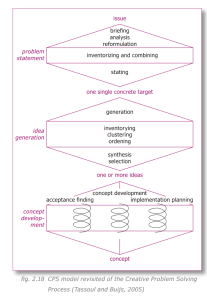Creativity Techniques
A Word about Creativity
Research shows that, on average, the more schooling one has the less creative they are on divergent thinking scores. See this for example. Unfortunately, you have had a lot of school to get to this point! However, creativity is NOT an inherent property of some people and not others. Research continues to show that being creative and innovative are learnable skills. Do not sell yourself short. But also, be prepared to work hard if you want to become more creative!
The following text is from the Delft Design Guide.
Daalhuizen, Jaap. 2018. Delft Design Approach, Delft University of Technology.
What Are Creativity Techniques?
The techniques for thinking up solutions to problems are called ‘creativity techniques’ or ‘creativity methods’. Most of these methods are general – they are applicable to a wide variety of problems. Creativity techniques are very useful in the design process, generating large amounts of ideas in a short time. There are many different creativity techniques, often classified according to structures like the following one (see Marc Tassoul, 2007):
Inventorying techniques: Techniques used to collect and recall all kinds of information around an issue. This helps in making an inventory of what we have in terms of ideas, or data, or whatever. Examples are Mind Maps (see ‘Mind Map’ in this section).
Associative Techniques: With associative techniques, great numbers of ideas and options are generated through association within a relatively short time. Association techniques encourage spontaneous reactions to ideas expressed earlier. An example of an associative technique is the brainstorming method (see ‘The Brainstorming Method’ in this section)
Confrontational Techniques: With confrontational techniques, ideas are generated by thinking outside one’s familiar frame of reference. By identifying and breaking assumptions, you are able to open up a wider solution space. New connections are made between the original issues in hand and a new idea through bisociation or force-fit. Completely new, unexpected combinations of viewpoints can arise, which bring the solution of the problem one step closer.
Provocative Techniques: With provocative techniques, assumptions and preconceptions are identified and broken from inside the familiar frame of reference (e.g. by asking questions like: “What if not?” and “What else?”). Provocative techniques make use of analogies, metaphors and random stimuli. Ideas will seem strange at first, but when force-fitted on the original issues they provoke new insights. Both confrontational and provocative techniques contain the principle of (1) making the strange familiar and (2) the familiar strange.
Intuitive Techniques: With intuitive techniques you develop a vision, or a new perspective on the original issue in hand. Intuitive techniques are useful for letting go: to guide the idea generation techniques by whatever comes to mind. It is a technique that allows for spontaneous and intuitive idea generation and reflecting upon the generated ideas. These techniques have a great influence on enthusiasm, motivation and courage of the team members.
Analytic-Systematic Techniques: Analytic-systematic methods are based on the analysis and systematic description of a problem, the drawing up of an inventory of solutions, variants to subproblems, and the systematic varying and combining of these solution variants. The morphological method and function analysis are the most typical examples (see ‘Function Analysis’ and ‘Morphological Chart’ in this section). Creative Problem Solving In order to apply the various creativity techniques effectively, a creative process needs to be followed. A very simple model of the creative process is provided by Wallas (1926): (1) preparation, (2) incubation, (3) illumination, and (4) verification. In the preparation phase the problem is defined. During the incubation phase, the issue is let go and attention is focused on other (inspirational) aspects. In the illumination phase an opening is (suddenly) found, from which an approach is developed to deal with the issue in hand. During the verification phase the idea is tested and evaluated. Tassoul and Buijs (2005) have modelled the creative problem-solving process in a more elaborate model, called the CPS model revisited (see figure 2.18). This model consists of three phases: (1) problem statement, (2) idea generation, and (3) concept development.

When Can You Use Creativity Techniques?
Creativity techniques are mostly used in a creative workshop, or in a brainstorm setting typically taking place at the beginning of the conceptual design phase, starting the phase of creating product ideas and concepts.
References and Further Reading
Tassoul, M. (2006) Creative Facilitation: a Delft Approach, Delft: VSSD.
Roozenburg, N.F.M. and Eekels, J. (1995) Product Design: Fundamentals and Methods, Utrecht: Lemma.
Roozenburg, N. and Eekels, J. (1998, 2nd ed.) Product Ontwerpen: Structuur en Methoden, Utrecht: Lemma.
Wallas, G. (1926, 1970) ‘The art of thought’, In: Vernon, P.E. (ed.) Creativity, Harmondsworth: Penguin.

